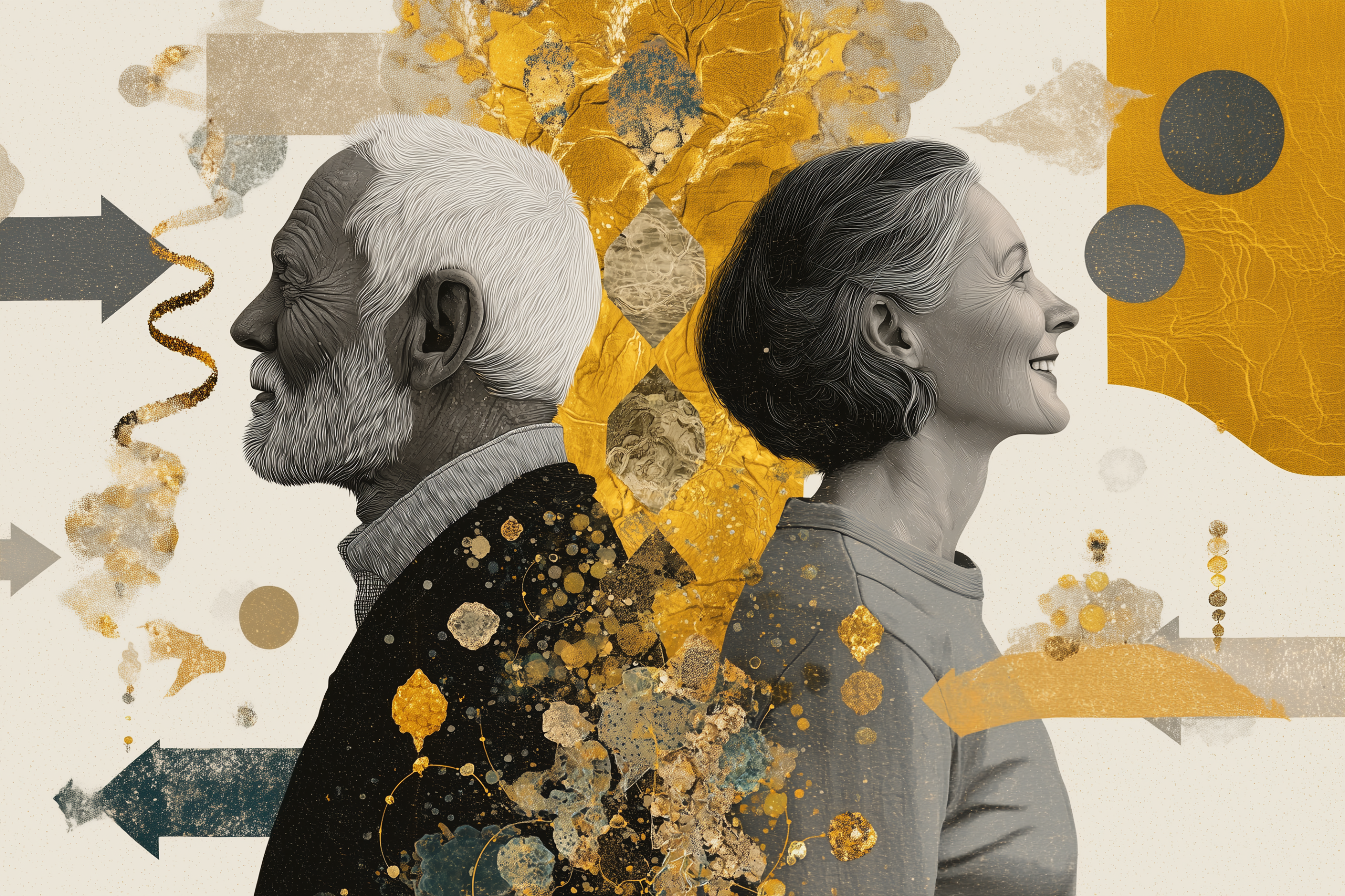Health doesn’t stick until it stops being what you do and starts being who you are.
Note: This article is for educational and informational purposes only. See full disclaimer at the end.
Most people treat health like a project—something with a start date, milestones, and hopefully an end date when they’ve “achieved” it. But what if that’s precisely why most health transformations fail?
We’ve spent 54 days exploring every facet of health transformation. We’ve dissected longevity science, decoded biological signals, harnessed technology, and even discovered how simple practices can add years to our lives. Yet there’s a fundamental truth we haven’t addressed: none of it matters unless health becomes who you are, not just what you do.
The research is unequivocal on this point. Behavioral scientists have discovered that [1] identity-based habits are far more powerful than outcome-based ones. When you focus on who you are rather than what you want to achieve, something profound happens in your brain. The behavior stops requiring willpower. It becomes automatic, effortless—it becomes you.
Think about the difference between “I’m trying to eat healthy” and “I’m someone who nourishes my body.” The first is a chore, a constant battle against your “real” self. The second is simply living according to your nature. One study found that [3] when habits become integrated with self-identity, they’re associated with stronger cognitive self-integration, higher self-esteem, and a natural striving toward an ideal self.

The Neuroscience of Becoming
Here’s what actually happens in your brain when health shifts from doing to being: your neural pathways literally rewire themselves. This isn’t metaphorical—it’s measurable, physical change. Neuroscientists call this process self-directed neuroplasticity, and it’s [12] how you intentionally reshape your brain to create automatic behaviors.
Every time you make a health choice aligned with your identity, neurons fire together in specific patterns. As Donald Hebb discovered in 1949, “neurons that fire together wire together.” With repetition, these neural pathways become [14] like well-worn hiking trails—the default route your brain takes without conscious effort.
The fascinating part? Research shows that [15] during early habit formation, your prefrontal cortex—the decision-making part of your brain—is highly active. But as the behavior becomes integrated into your identity, it shifts to the basal ganglia, where automatic behaviors live. This is why someone who identifies as “a runner” doesn’t debate whether to run. They just lace up their shoes.
This neural transformation typically takes [15] anywhere from 18 to 254 days, with an average of 66 days. But here’s the crucial insight: habits tied to identity form faster and stick longer than those pursued for external rewards. When the behavior reflects who you are, your brain treats it as essential, not optional.
The Identity Paradox
Most health advice gets this backwards. It tells you to change your behaviors to become healthy. But research on identity transformation reveals the opposite path: [7] significant behavior change often begins with an identity shift, not the other way around. A comprehensive analysis of 399 people who successfully changed unhealthy behaviors found that lasting change started when they began seeing themselves differently.
This creates what I call the identity paradox: you can’t wait until you’re healthy to see yourself as a healthy person. You must claim the identity first, then let your behaviors align with that identity. It feels backwards because it is backwards—at least compared to how we’re taught change works.
Consider how this plays out in real life. Someone who says “I don’t eat sugar” has a fundamentally different relationship with dessert than someone who says “I’m trying to cut back on sugar.” The first person has made a identity declaration; the second is in perpetual negotiation. Research on social identity and health behaviors found [5] that when health behaviors align with social identity, the effect is present not just for intentions but for actual behavior.
The Maintain IT model from behavioral science shows that [2] when health behaviors become part of centered identity transformation, they require less executive function to maintain. In other words, when being healthy is who you are, it stops requiring constant willpower. Your brain shifts from System 2 processing (slow, deliberate, effortful) to System 1 processing (fast, automatic, effortless).

The Compounding Effect
When health becomes identity, something remarkable happens: every healthy choice reinforces who you are, and who you are drives every healthy choice. It’s a positive feedback loop that compounds over time.
James Clear, in his research on atomic habits, notes that [1] “your current behaviors are a pretty accurate reflection of your current identity.” But the powerful part is that it works in reverse: claiming an identity drives behaviors that reinforce that identity. Each action becomes a vote for the type of person you want to be.
This compounding effect extends beyond individual behaviors. When you identify as someone who prioritizes health, you naturally:
- Seek out environments that support that identity
- Surround yourself with people who reinforce it
- Make decisions through the lens of that identity
- Recover faster from setbacks because they don’t threaten who you are
Research on habit formation shows that [4] identity-based habits promote consistency even through life’s predictable ups and downs. You’re more likely to maintain healthy behaviors during stress, travel, or disruption when they’re tied to identity rather than goals.
The Social Dimension
Identity doesn’t exist in isolation. We are, as Aristotle noted, social animals. Our identities are shaped by and expressed through our relationships with others. This social dimension of health identity is perhaps its most powerful and overlooked aspect.
Studies on social identity and health behavior show [9] that the association between identity and behavior is strongest when it involves health-related social identities. When you publicly claim your health identity—not as bragging but as simple declaration of who you are—you activate powerful social reinforcement mechanisms.
But here’s where conscious health mastery diverges from typical behavior change: it’s not about external accountability or social pressure. It’s about aligning your internal identity with your external expression. When someone offers you something that doesn’t align with your health identity, saying no isn’t hard—it’s automatic. You’re not rejecting the offer; you’re simply being yourself.
This social dimension also explains why health transformations often seem contagious. When one person in a social network genuinely embodies health as identity, it [6] creates ripple effects. Not through preaching or pushing, but through simple demonstration that another way of being is possible.

Beyond Individual Choice
The traditional model of health positions it as a series of individual choices: eat this, don’t eat that, exercise more, sleep better. But when health becomes identity, it transcends individual choice. It becomes what researchers call [10] an integrated life pattern—a coherent way of being that encompasses all your choices without requiring constant decision-making.
This shift from choice to identity solves one of the fundamental problems of health behavior: decision fatigue. The average person makes over 200 food-related decisions daily. When each one requires willpower, eventual failure is almost guaranteed. But when you identify as someone who honors their body, many of those decisions disappear. You don’t debate whether to have the second cookie—it simply doesn’t occur to you.
This doesn’t mean perfection. Identity-based health includes understanding that [8] flexible, adaptive responses to changing circumstances are part of being truly healthy. Someone who has integrated health into their identity doesn’t panic over a missed workout or an indulgent meal. They understand these as normal variations within their overall pattern of being.
The Integration Process
So how do you actually make this shift from doing health to being health? The neuroscience suggests several key mechanisms:
First, [13] you must engage in what researchers call “self-directed neuroplasticity”—consciously directing your brain’s rewiring process. This isn’t passive hope; it’s active mental rehearsal. Visualization isn’t just new-age thinking; it’s [1] literally practicing neural pathways. When you repeatedly visualize yourself as someone who makes healthy choices naturally, you’re building the neural infrastructure for that identity.

Second, language matters more than most realize. Researchers studying identity transformation found that [1] using your own name in action statements (“Alex is the type of person who prioritizes morning movement”) helps solidify identity shifts. This isn’t affirmation for affirmation’s sake—it’s deliberately programming your brain’s self-concept.
Third, start with keystone identity shifts. Not all aspects of health identity are equal. Some create cascade effects. For instance, identifying as “someone who moves daily” often naturally leads to better sleep, nutrition, and stress management. The key is finding the identity shift that feels most authentic and building from there.
The Paradox of Effort
Here’s perhaps the most counterintuitive aspect of health mastery: the more it becomes your identity, the less effort it requires. This seems to violate everything we believe about achievement, but the neuroscience is clear. [11] Habits that are integrated into identity operate from different brain regions than goal-directed behaviors. They require less glucose, less conscious attention, less willpower.
This is why people who have achieved true health mastery often seem puzzlingly relaxed about it. They’re not constantly fighting themselves. They’re not using elaborate systems of rewards and punishments. They’re simply being themselves. Their health practices have become as automatic as brushing their teeth—present but not consuming.
This doesn’t mean the journey to integration is effortless. The initial identity shift requires [16] sustained, deliberate focus. But unlike willpower-based approaches that get harder over time as willpower depletes, identity-based transformation gets easier as neural pathways strengthen.

The Complete Integration
After 54 days of exploring health from every angle—biological, technological, psychological, social—we arrive at this simple truth: conscious health mastery isn’t about perfecting a system of behaviors. It’s about becoming someone for whom health is as natural as breathing.
This isn’t a rejection of everything we’ve learned. The frameworks, the science, the protocols—they all matter. But they matter as expressions of identity, not as external impositions. When you identify as someone who consciously manages their health, you naturally seek out and apply the knowledge that serves that identity.
The ultimate paradox of conscious health mastery is that it’s simultaneously the simplest and most profound transformation possible. Simple because it’s just a shift in self-concept. Profound because that shift changes everything—how you think, how you choose, how you live, who you become.
As we stand at Day 97 of this 162-day journey, approaching our Day 100 milestone, remember this: health isn’t something you achieve. It’s someone you become. And that becoming isn’t a future state—it’s available right now, in this moment, with your next choice.
Not as a behavior to perform, but as an expression of who you are.
See you in the next insight.
Comprehensive Medical Disclaimer: The insights, frameworks, and recommendations shared in this article are for educational and informational purposes only. They represent a synthesis of research, technology applications, and personal optimization strategies, not medical advice. Individual health needs vary significantly, and what works for one person may not be appropriate for another. Always consult with qualified healthcare professionals before making any significant changes to your lifestyle, nutrition, exercise routine, supplement regimen, or medical treatments. This content does not replace professional medical diagnosis, treatment, or care. If you have specific health concerns or conditions, seek guidance from licensed healthcare practitioners familiar with your individual circumstances.
References
The references below are organized by study type. Peer-reviewed research provides the primary evidence base, while systematic reviews synthesize findings.
Peer-Reviewed / Academic Sources
- [1] Hinge Health, (2024). Identity: A Powerful Tool for Building Healthy Habits. Hinge Health. https://www.hingehealth.com/resources/articles/identity-and-habits/
- [2] National Center for Biotechnology Information, (2018). Harnessing Centered Identity Transformation to Reduce Executive Function Burden for Maintenance of Health Behavior Change: The Maintain IT Model. PMC. https://pmc.ncbi.nlm.nih.gov/articles/PMC6124500/
- [3] National Center for Biotechnology Information, (2019). Habit and Identity: Behavioral, Cognitive, Affective, and Motivational Facets of an Integrated Self. PMC. https://pmc.ncbi.nlm.nih.gov/articles/PMC6635880/
- [4] National Center for Biotechnology Information, (2012). Making health habitual: the psychology of ‘habit-formation’ and general practice. PMC. https://pmc.ncbi.nlm.nih.gov/articles/PMC3505409/
- [5] de Hoog, N., & Pat-El, R., (2024). Social identity and health-related behavior: A systematic review and meta-analysis. ScienceDirect. https://www.sciencedirect.com/science/article/pii/S027795362400073X
- [6] National Center for Biotechnology Information, (2025). Health behavioural change – the influence of social-ecological factors and health identity. PMC. https://pmc.ncbi.nlm.nih.gov/articles/PMC11789218/
- [7] Kearney, M.H., & O’Sullivan, J., (2003). Identity shifts as turning points in health behavior change. PubMed. https://pubmed.ncbi.nlm.nih.gov/12666640/
- [8] National Center for Biotechnology Information, (2018). Centered Identity Transformation Model for Health Behavior Maintenance. PMC. https://pmc.ncbi.nlm.nih.gov/articles/PMC6124500/
- [9] de Hoog, N., et al., (2024). Social identity and health-related behavior: A systematic review and meta-analysis. ScienceDirect. https://www.sciencedirect.com/science/article/pii/S027795362400073X
Government / Institutional Sources
- [10] National Center for Biotechnology Information, (2014). Social Determinants and Health Behaviors: Conceptual Frames and Empirical Advances. PMC. https://pmc.ncbi.nlm.nih.gov/articles/PMC4511598/
- [11] National Center for Biotechnology Information, (2019). Creatures of Habit: The Neuroscience of Habit and Purposeful Behavior. PMC. https://pmc.ncbi.nlm.nih.gov/articles/PMC6701929/
Industry / Technology Sources
- [12] Healthline, (2021). The Science of Habit: How to Rewire Your Brain. Healthline. https://www.healthline.com/health/the-science-of-habit
- [13] Access Therapy, (2024). 7 Principles of Neuroplasticity: Breaking Bad Habits & Boosting Your Brain. Access Therapy. https://www.accesstherapy.ca/speaking-with-my-therapist-blog/principles-of-neuroplasticity
- [14] Authenticity Associates, (2024). Neural Plasticity: 4 Steps to Change Your Brain & Habits. Authenticity Associates. https://www.authenticityassociates.com/neural-plasticity-4-steps-to-change-your-brain/
- [15] The Conversation, (2025). Here’s what happens in your brain when you’re trying to make or break a habit. The Conversation. https://theconversation.com/heres-what-happens-in-your-brain-when-youre-trying-to-make-or-break-a-habit-201189
- [16] Colorado State University Center for Healthy Aging, (2025). How to rewire your brain. CSU. https://www.research.colostate.edu/healthyagingcenter/2022/05/31/how-to-rewire-your-brain/


